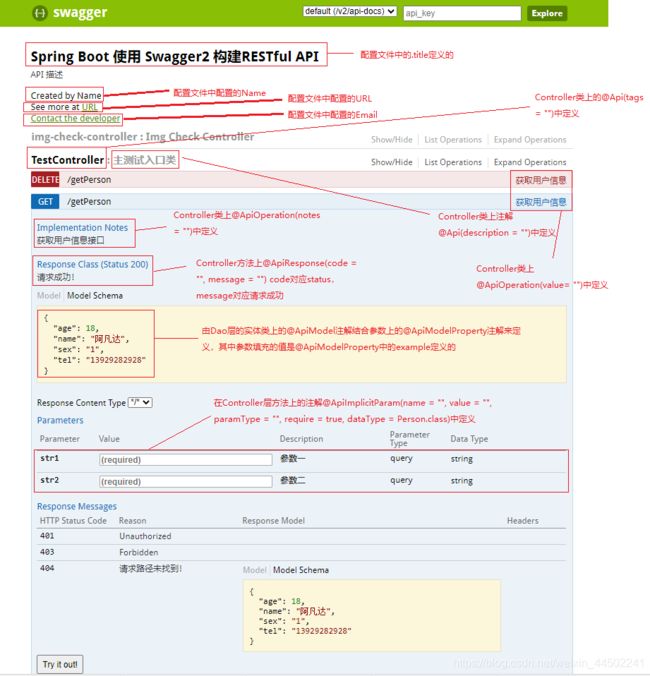SpringBoot整合Swagger及简单使用
SpringBoot整合Swagger及简单使用
- 1. pom.xml文件引入相关的jar包
- 2. 创建Swagger配置类,配置Swagger
- 3.在需要配置的地方使用@Api***相关注解进行相关的配置
- 4. 配置多个Controller
- 方法一:指定配置文件api包为controller公共的父包
- 方法二:根据共有注解去扫描Controller
1. pom.xml文件引入相关的jar包
<dependency>
<groupId>io.springfoxgroupId>
<artifactId>springfox-swagger2artifactId>
<version>2.5.0version>
dependency>
<dependency>
<groupId>io.springfoxgroupId>
<artifactId>springfox-swagger-uiartifactId>
<version>2.5.0version>
dependency>
2. 创建Swagger配置类,配置Swagger
package com.example.demo.config;
import springfox.documentation.service.Contact;
import org.springframework.context.annotation.Bean;
import org.springframework.context.annotation.Configuration;
import springfox.documentation.builders.ApiInfoBuilder;
import springfox.documentation.builders.PathSelectors;
import springfox.documentation.builders.RequestHandlerSelectors;
import springfox.documentation.service.ApiInfo;
import springfox.documentation.spi.DocumentationType;
import springfox.documentation.spring.web.plugins.Docket;
import springfox.documentation.swagger2.annotations.EnableSwagger2;
/**
* Created by Zpy on 2020/04/28.
*/
@Configuration
@EnableSwagger2
public class SwaggerApp {
@Bean
public Docket createRestApi() {
return new Docket(DocumentationType.SWAGGER_2)
.apiInfo(apiInfo())
.select()
// 存放接口的Controller的包路径
.apis(RequestHandlerSelectors.basePackage("com.example.demo.controller"))
.paths(PathSelectors.any())
.build();
}
//构建api文档的详细信息函数,注意这里的注解引用的是哪个
private ApiInfo apiInfo() {
return new ApiInfoBuilder()
//页面标题
.title("Spring Boot 使用 Swagger2 构建RESTful API")
//创建人
.contact(new Contact("Name", "URL", "Email"))
//版本号
.version("1.0")
//描述
.description("API 描述")
.build();
}
}
3.在需要配置的地方使用@Api***相关注解进行相关的配置
Controller层注解示例:
package com.example.demo.controller;
import com.example.demo.entry.Person;
import com.example.demo.service.IPersonService;
import io.swagger.annotations.*;
import org.springframework.beans.factory.annotation.Autowired;
import org.springframework.stereotype.Controller;
import org.springframework.web.bind.annotation.RequestMapping;
import org.springframework.web.bind.annotation.ResponseBody;
import java.util.ArrayList;
import java.util.List;
@Controller
@Api(description = "主测试入口类", tags = "TestController")
public class TestController {
@RequestMapping("/getPerson")
@ResponseBody
@ApiOperation(value = "获取用户信息", notes = "获取用户信息接口")
@ApiImplicitParams({
@ApiImplicitParam(name = "str1", value = "参数一", paramType = "query", required = true, dataType = "String"),
@ApiImplicitParam(name = "str2", value = "参数二", paramType = "query", required = true, dataType = "String")
})
@ApiResponses({
@ApiResponse(code = 200, message = "请求成功!", response = Person.class),
@ApiResponse(code = 404, message = "请求路径未找到!", response = Person.class)
})
public List<Person> getMap(@ApiParam(name = "str1", value = "参数一", required = true) String str1, String str2) {
System.out.println("参数一输出:" + str1 + ", \n参数二输出:" + str2);
ArrayList<Person> list = new ArrayList<>();
list.add(new Person("张三", 15, "13728726789", Byte.valueOf("1")));
return list;
}
}
Dao层注解示例:
package com.example.demo.entry;
import io.swagger.annotations.ApiModel;
import io.swagger.annotations.ApiModelProperty;
import lombok.AllArgsConstructor;
import lombok.Data;
import lombok.NoArgsConstructor;
import lombok.ToString;
import org.springframework.stereotype.Repository;
@Data
@NoArgsConstructor
@AllArgsConstructor
@ToString
@Repository
@ApiModel(value = "Person对象", description = "用户对象")
public class Person {
@ApiModelProperty(value = "名称", dataType = "String", name = "name", example = "阿凡达", required = false, hidden = false)
private String name;
@ApiModelProperty(value = "年龄", dataType = "Integer", name = "age", example = "18", required = false, hidden = false)
private Integer age;
@ApiModelProperty(value = "手机号", dataType = "String", name = "tel", example = "13929282928", required = false, hidden = false)
private String tel;
@ApiModelProperty(value = "性别", dataType = "byte", name = "sex", example = "1", required = false, hidden = false)
private byte sex;
}
本项目端口号8091,访问路径:http://localhost:8091/swagger-ui.html展示:

4. 配置多个Controller
方法一:指定配置文件api包为controller公共的父包
package com.example.config;
import com.google.common.base.Predicate;
import com.google.common.base.Predicates;
import io.swagger.annotations.Api;
import springfox.documentation.RequestHandler;
import springfox.documentation.service.Contact;
import org.springframework.context.annotation.Bean;
import org.springframework.context.annotation.Configuration;
import springfox.documentation.builders.ApiInfoBuilder;
import springfox.documentation.builders.PathSelectors;
import springfox.documentation.builders.RequestHandlerSelectors;
import springfox.documentation.service.ApiInfo;
import springfox.documentation.spi.DocumentationType;
import springfox.documentation.spring.web.plugins.Docket;
import springfox.documentation.swagger2.annotations.EnableSwagger2;
/**
* Created by zpy on 2020/04/21.
*/
@Configuration
@EnableSwagger2
public class SwaggerApp {
@Bean
public Docket createRestApi() {
return new Docket(DocumentationType.SWAGGER_2)
.apiInfo(apiInfo())
.select()
.apis(RequestHandlerSelectors.basePackage("com.example"))
.paths(PathSelectors.any())
.build();
}
//构建 api文档的详细信息函数,注意这里的注解引用的是哪个
private ApiInfo apiInfo() {
return new ApiInfoBuilder()
//页面标题
.title("Spring Boot 使用 Swagger2 构建RESTful API")
//创建人
.contact(new Contact("Name", "URL", "Email"))
//版本号
.version("1.0")
//描述
.description("API 描述")
.build();
}
}
方法二:根据共有注解去扫描Controller
package com.example.config;
import com.google.common.base.Predicate;
import com.google.common.base.Predicates;
import io.swagger.annotations.Api;
import springfox.documentation.RequestHandler;
import springfox.documentation.service.Contact;
import org.springframework.context.annotation.Bean;
import org.springframework.context.annotation.Configuration;
import springfox.documentation.builders.ApiInfoBuilder;
import springfox.documentation.builders.PathSelectors;
import springfox.documentation.builders.RequestHandlerSelectors;
import springfox.documentation.service.ApiInfo;
import springfox.documentation.spi.DocumentationType;
import springfox.documentation.spring.web.plugins.Docket;
import springfox.documentation.swagger2.annotations.EnableSwagger2;
/**
* Created by zpy on 2020/04/21.
*/
@Configuration
@EnableSwagger2
public class SwaggerApp {
@Bean
public Docket createRestApi() {
return new Docket(DocumentationType.SWAGGER_2)
.apiInfo(apiInfo())
.select()
.apis(RequestHandlerSelectors.withClassAnnotation(Api.class))
.paths(PathSelectors.any())
.build();
}
//构建 api文档的详细信息函数,注意这里的注解引用的是哪个
private ApiInfo apiInfo() {
return new ApiInfoBuilder()
//页面标题
.title("Spring Boot 使用 Swagger2 构建RESTful API")
//创建人
.contact(new Contact("Name", "URL", "Email"))
//版本号
.version("1.0")
//描述
.description("API 描述")
.build();
}
}